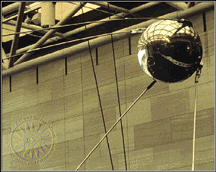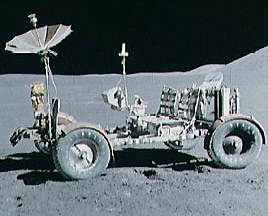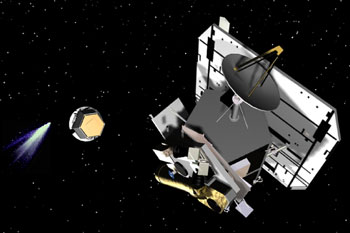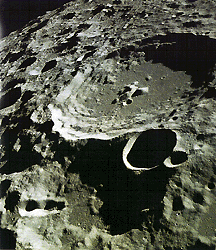Picture of Moon's farside
NASA
Luna
With increased confidence from the success of their Sputnik missions, the Soviet Union launched 24 Luna spacecrafts to the Moon, between 1959 and 1976. 15 were successful, each designed as either an orbiter or lander, and accomplished many firsts in space exploration.
Luna 1 missed its intended impact with the Moon and became the first spacecraft to fall into orbit around the Sun. In 1959, the second Luna mission successfully impacted the lunar surface, becoming the first man-made object to reach another world. Luna 3 orbited the Moon later that year, and returned the first photographs of its far side, which can never be seen from Earth.
The Soviet Union soon learned to build spacecrafts which could perform soft landings on the lunar surface, and send back images from their landing sites. Lunas 17 and 21 even carried vehicles which could explore the Moon's terrain.
Another major achievement of the Luna program was the ability to collect samples of lunar soil and return them to Earth, by 1970. However, these accomplishments were overshadowed by the U.S. Apollo missions which had already placed humans on the Moon by this time.
You might also be interested in:

The Soviet Sputnik program consisted of four satellites, three of which reached Earth orbit. Sputnik 1, launched on Oct.4, 1957, became the first artificial satellite to successfully orbit the Earth. It
...more
Apollo 11 was the first mission that landed a person on the moon. On July 16, 1969, the U. S. rocket Saturn 5 was launched carrying the lunar landing module Eagle. The Eagle was released and it reached
...more
The Hubble Space Telescope (HST) is really neat! It was first launched in 1990, but scientists started building it in the 1970's! We have found all kinds of objects like stars, nebulae and galaxies. The
...more
Apollo 12 was launched on Nov. 14, 1969 and arrived at the Moon three days later. Astronauts Charles Conrad and Alan Bean descended to its surface, while Richard Gordon remained in lunar orbit aboard the
...more
Apollo 15 marked the start of a new series of missions from the Apollo space program, each capable of exploring more lunar terrain than ever before. Launched on July 26, 1971, Apollo 15 reached the Moon
...more
NASA chose Deep Impact to be part of a special series called the Discovery Program. This program is for cheap, scientific projects. In May 2001, NASA said it was ok to start with mission development for
...more
Galileo was a spacecraft that orbited Jupiter for eight years. It made many discoveries about Jupiter and its moons. Galileo was launched in 1989, and reached Jupiter in 1995. The spacecraft had two parts.
...more















